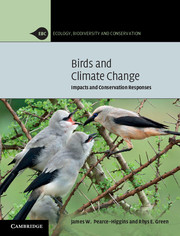Book contents
- Frontmatter
- Dedication
- Contents
- Foreword
- Acknowledgements
- 1 Birds and climate change
- Part I Impacts
- Part II Conservation responses
- 6 Using models to predict the effects of climate change on birds
- 7 Conservation in a changing climate
- 8 Effects of climate change mitigation on birds
- 9 Overall conclusions
- References
- Index
6 - Using models to predict the effects of climate change on birds
Published online by Cambridge University Press: 05 June 2014
- Frontmatter
- Dedication
- Contents
- Foreword
- Acknowledgements
- 1 Birds and climate change
- Part I Impacts
- Part II Conservation responses
- 6 Using models to predict the effects of climate change on birds
- 7 Conservation in a changing climate
- 8 Effects of climate change mitigation on birds
- 9 Overall conclusions
- References
- Index
Summary
Introduction
Having described the impacts that climate change has already had upon birds, their populations, distributions and communities, in this second part of the book, we look now at what can be done to reduce the negative impacts of current and future climate changes on birds. The first stage in attempting to do this is to predict what the consequences of future climate change will be for the conservation status of wild species and populations. Although there are many impacts of climate change which have been documented, few clearly demonstrate a current and urgent threat to particular populations or species. For most species, it is not the climate change which has occurred so far that is the problem, but the magnitude of climate change to come. In this chapter, we attempt to quantify the likely size of that future problem – how severe is the impact of climate change on birds likely to be?
This is not a simple question to answer. The foregoing chapters documented the complexity of the effects of climate and climatic change on reproductive and mortality rates of birds, which are the mechanisms by which climate affects their distribution and abundance. Given this complexity, it might be thought that any attempt to predict the effect of climate change on a bird species would require a detailed knowledge of how its demographic rates will be affected, in both the short and the long term. Such knowledge can certainly be very helpful as we shall see later in this chapter, but realistically, is only available for a handful of the 10 000 bird species on Earth. To make an assessment that will be widely applicable, we need to consider alternative approaches, which require less detailed information, to predicting the effects of climate change on bird species. Building on the role of climate in delimiting species’ distributions (Sections 1.8 and 5.2), the most widely used approach is to build a statistical model of geographical variation in the distribution or abundance of a species in relation to climatic and sometimes also to other environmental variables. The spatial association between a species and climate described by that model is then used to make future projections of the impact that climate change may have on that species’ distribution or abundance.
- Type
- Chapter
- Information
- Birds and Climate ChangeImpacts and Conservation Responses, pp. 201 - 249Publisher: Cambridge University PressPrint publication year: 2014



